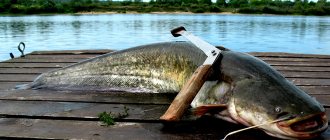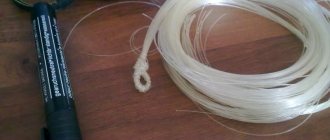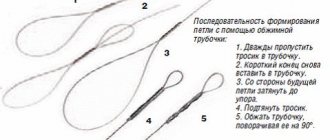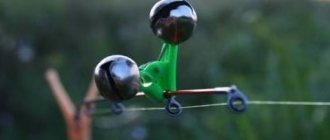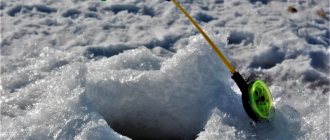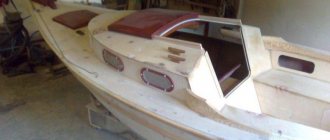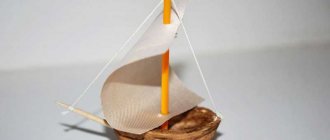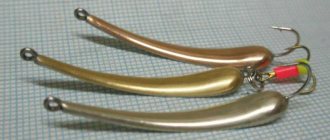What is a spinnerbait?
Content
A spinnerbait is an artificial bait for catching predatory fish. It consists of one or two (rarely more) metal petals and a head with a hook, equipped with a voluminous soft bait (usually a “skirt”). The elements are connected to each other by a wire beam. Thanks to the resistance created by the petals in the water, the bait is always oriented vertically when retrieved, which allows it to pass between plant stems without snagging. Also, hooks are prevented by the springy properties of the wire rocker, which, when compressed, allows the spinnerbait to pass between snags and other obstacles.
To catch predatory fish, such as pike or perch, fishermen use homemade baits
Invented in the USA for catching bass and muskie, the spinnerbait was liked by our pike and perch, like many other American baits. Other fish rarely bite on it. Fishing with a spinnerbait can be carried out using uniform wiring in different layers of water or a step with a slightly smaller number of pauses than when fishing with silicone.
Jig spinnerbait
In addition to the classic ones, you can make a more practical jig spinnerbait. The production of this type of bait is described in detail in one of the episodes of the “Fisherman’s Workshop with the Shcherbakov brothers.” The use of such a spinnerbait is much more practical because it has a fastener on the lower arm of the rocker, which allows you to quickly change the used sinkers and baits. Thus, the fisherman will not need to make several dozen spinnerbaits - it will be quite enough to have 2-3, as well as replaceable baits for them.
Parts and tools
How a Jig Rig is made
To make this type of spinnerbait you must have:
- Steel string with a diameter of 0.8 millimeters;
- Long shaped petal;
- Jig head;
- Silicone bait.
The set of tools for making this type of spinnerbait will also be somewhat different:
- Long nose pliers;
- Soldering iron;
- Wire cutters.
This is where the equipment needed to make a jigging spinnerbait ends. The main advantage in the manufacture of this design is that there is no need to cast a sinker, which speeds up the manufacturing process several times and also reduces the cost of the necessary set of tools.
Manufacturing process
Making a jig spinnerbait for pike using the Shcherbakovs’ method is carried out as follows:
- A piece of string about 30 centimeters long is cut.
- At a distance of approximately 10 centimeters from the upper end, a loop is made using long-nose pliers, and the angle between the arms of the future rocker should be 90 degrees.
- A loop is made at the upper end of the rocker in one turn, as on standard fishing hooks, but is not bent all the way.
- The end of the loop is threaded into the eye of the swivel.
- The edge of the loop is pressed tightly to the base.
- The petal is cut off with pliers from the side in the area of the eye so that the eye of the swivel can be threaded into the hole of the petal.
- The swivel is threaded into the hole of the petal.
- The cut edges of the petal are tightly folded back.
- A standard wire fastener is formed on the lower edge of the rocker arm. The free end of the fastener, when closed, should be directed in the same direction as the upper arm of the rocker so as not to create a snagging element.
- Using a soldering iron, the middle loop of the rocker arm, the swivel fastening loop are spot-soldered, and the cut in the petal is soldered with care so as not to solder the hole.
One of the variants of a jig spinnerbait is a design with a non-removable sinker, which allows it to more easily overcome underwater vegetation, but at the same time deprives the angler of the ability to change the weight of the load when fishing conditions change.
At this point, the jig spinnerbait can be considered ready. Using a fastener on the lower arm of the rocker, any jig head with any silicone bait that will be considered promising by the angler is attached to the structure.
Peculiarities
The speed at which the bait falls to the bottom depends on the choice of petal shape. Rotating, it plays the role of a small parachute, slowing down the movement of the jig head. The more elongated the petal is, the less it slows down its fall. Therefore, elongated petals, the shape of which is called long, are usually used when fishing in holes and at great depths, when fishing occurs near the bottom. This allows the spinnerbait to drop faster. Using wider blade options, such as aglia or colorado, will help keep the bait easier in the water column and closer to the surface, which is especially important when fishing for perch.
The thickness of the spinnerbait spinner should be minimal, since a heavy petal attached through a shock-absorbing rocker will not provide the required rotation speed and will contribute to incorrect play of the entire bait. Also, you should not make it too large, since in this bait it is a secondary element.
When fishing for perch, it is worth using a wire of a smaller diameter than when fishing for pike, since a rocker that is too thick can alert the striped predator, while it itself is rarely able to deform the wire. Also, when fishing for this fish, there is no need to make the lower arm of the frame long, since when fishing for pike it primarily serves as a metal leash. That is why this structural element in the pike version is made about twenty centimeters long.
When making spinnerbaits, it is preferable to use an elongated or cone-shaped sinker. The classic round jig head clings to underwater vegetation, which significantly limits the efficiency of movement of this type of bait through difficult places. This is true both in the manufacture of classic spinnerbaits and for jig variations. It is better to use round sinkers only on reservoirs with a clean bottom.
How to make a spinnerbait yourself?
Commercially available spinnerbaits, despite their variety, do not always meet the fishing conditions. This is especially true for small-sized baits designed for perch. Anglers often have to make changes to the design of a spinnerbait or even make it from scratch. It may also be necessary to replace a lost catchable bait that has been discontinued and is not available for sale.
Let's try to figure out how to make a spinnerbait with your own hands. Practice shows that this is not so difficult if you have the necessary materials and tools. It is also necessary to have an idea of the design of the bait or a sample of it.
Read more
How to catch catfish from the shore?
How to make a spinnerbait with your own hands, step-by-step instructions with photos
First of all, we take the wire and bite off a 30-centimeter piece. In the middle of this piece of wire we make a bend using pliers. We should get a loop in the middle of the wire:
Next, we again insert the pliers into the loop and make one turn of the wire to get the following configuration:
The next step is to make a fastener on which the silicone bait would be attached. We take pliers and grab the wire at this distance:
We begin to bend the clasp. We make the same loop:
Then we insert pliers into the ring and bend the ends of the wire so that we get the following design:
After this, we bend the short end of the wire in this way:
After this, we bend the wire again with round pliers and get this beautiful fastener:
The fastener should fit well on the wire and be easy to unfasten. And one more important point: the clasp is located perpendicular to the ring, as in this case:
You can insert a silicone fish with a weight in the form of a ball, a twister or a vibrating tail into this fastener. This part of the spinnerbait is ready.
We move on to the second half of the bait, to which the petals will be attached. First we put on two beads.
Next we put on the smaller petal. To do this, we take a clamp, insert it into the petal and thread the clamp with the petal into the wire
Here it is very important to dress the petal so that the convex part looks at you. You need to do this:
If you place the petal on the other side, it will not rotate. After this operation we put on the three remaining beads.
Now we just have to thread the second petal. On the shoulder where we have the petals, we measure a distance equal to the length of the second shoulder and make a bend with pliers:
We thread the swivel with the clasp and insert it into this ring:
Next, we take the pliers and thread them into the ring and make several turns around the wire:
It turns out like this:
We cut off the excess wire with wire cutters so that we get a neat ear.
We will insert the second petal into the clasp. We will thread the silicone bait into the second fastener. As a result, I ended up with this homemade spinnerbait:
This design has a good feature. You can quickly change two elements: a jig bait and a large petal. All you need to do is have petals of different shapes and sizes, as well as artificial fish of different colors and configurations. If you catch, for example, perch, then you put small and medium-sized petals and fish, and for pike you already install larger elements. This feature of the spinnerbait makes it a universal bait that can be configured in different ways depending on fishing conditions and fishing objects.
As you know, the petal attracts fish, and the silicone is attacked by the predator. Therefore, the fish is made brighter and more noticeable in the water. During postings, each element demonstrates a certain game. The predator reacts positively to vibrations coming from the bait.
Another advantage of a spinnerbait is that it rarely gets caught on snags and grass. When he passes obstacles, the wire mustache simply bends around them.
Read How to catch roach in autumn and choose working baits
Good fishing online stores
will allow you to purchase any fishing goods at competitive prices!
Subscribe to us - through them we publish a lot of interesting information, photos and videos.
Popular sections of the site:
The fisherman's calendar will allow you to understand how all the fish bite depending on the time of year and month.
The fishing gear page will tell you about many popular gear and devices for fishing.
Fishing baits - we describe in detail live, plant, artificial and unusual ones.
In the bait article you will get acquainted with the main types, as well as tactics for using them.
Learn all the fishing lures to become a real fisherman and learn how to choose the right one.
Design features of the spinnerbait
The basis of the bait is a beam made of thin elastic wire, bent at an angle close to a straight line. In its middle there is an open or closed loop to which a fishing line or leash is attached.
While moving in the water, this bait becomes in a vertical position, in which there is a hook with a “skirt” at the bottom, and a rotating petal at the top.
One or more petals are installed on the upper arm, creating vibrations that are attractive to fish. To ensure freedom of rotation, the upper petal is mounted on a high-quality swivel.
There are two main petal shapes:
- “Colorado” is an almost round petal that creates strong vibrations and has maximum resistance in water;
- “willow leaf” is an elongated petal with pointed ends. Lures with such petals sink faster and go deeper, and their vibration is weaker.
A weight-head with a hook, similar to a jig, is attached to the lower arm. The shape of the head is “fish head”, which ensures high maneuverability of the bait. The head weight usually ranges from 7 to 28 g.
The spinnerbait hook is equipped with a skirt - a voluminous bundle of rubber or silicone threads. The purpose of the skirt is to act as a “parachute” that slows down the dive of the bait, and to create a “target” that the fish attacks when biting. Sometimes the skirt is replaced or supplemented with a trailer - a silicone bait (vibrotail, twister, octopus).
What does the skirt of a homemade spinnerbait consist of?
As mentioned above, the vast majority of spinnerbaits come with a skirt. The skirt for a DIY spinnerbait can be purchased ready-made or made independently. Homemade skirts are made from rubber bands or thinly cut strips of silicone. It is also possible to make a skirt from a voluminous fur tassel - bucktail.
You can use multi-colored pieces of elastic to attach banknotes or multi-colored silicone cut into strips
When fastening a classic skirt, you need to pay attention to the fact that half of its threads are directed forward. This is how the required volume is created.
Materials for a homemade spinnerbait
To make a spinnerbait you must have:
- elastic, preferably stainless wire with a diameter of 0.6-1.0 mm;
- offset, jig or other hook with a long shank;
- mounting accessories – winding rings, swivels, stopper beads;
- ready-made petals or material for their manufacture;
- lead or solder containing lead.
To simplify the manufacture of bait, you can use a ready-made jig head of a suitable shape and weight.
DIY spinnerbaits
First you need to decide what size the future bait will be.
Very often, a homemade spinnerbait has an upper arm length of three centimeters, and the lower arm is two millimeters longer than the upper one. Total weight: five grams. Immediately you need to secure the wire to the hook. The wire is threaded through the eye of the hook and wrapped several times for strength. Excess wire is cut off with wire cutters. The rest is placed into the mold at the joint and filled with lead. Next, you need to wait a little while the molten lead cools down.
Now you need to step back a little from the sinker to the place where the wire will bend to create an L-shape. Now you need to bend the wire into a small loop - a ring. After that there was a line for the petal. It is best that its thickness is no more than 0.3 millimeters. The wire is bent into a loop. The beads should be fixed between the loops. It can also be secured through a small ring, which can be made from wire of the same thickness. The second petal is attached using a swivel and a second winding ring.
Necessary tools for work
Given the simple technology, when making a spinnerbait you can get by with a minimum of tools. Only pliers are required. Pliers, a mold for casting or a metal file and a soldering iron are desirable.
Read more
What tackle to choose for grayling?
Stainless steel wire about 1mm thick. As a rule, “stainless steel” is quite strong, can bend without difficulty and at the same time is able to retain its shape.
If you make petals yourself, you will need metal scissors, a needle file, a thin drill or punch, a hammer and a die with a punch. The latter can be replaced with a bearing ball and a plate with a recess.
Making baits
Nowadays, making your own baits has become fashionable again. This is due to the small range of branded baits, the relatively high price of them, or both factors together. Spinnerbaits fall into the latter category. We already have a guide to making different types of spinnerbaits, but we’ll touch on the technology a little here too.
Necessary materials
- spring wire with a cross section of 1 mm;
- hook with a long shank;
- swivel and two rings;
- beads (will be used as a stopper);
- two petals (you can use branded ones or make them from stainless steel 0.3 mm thick);
- casting mold;
- lead;
- pliers, pliers;
Manufacturing process
- We pass the wire into the eye of the hook and secure the latter in the casting mold, after which we bite off the excess wire.
- Cover the hook with another part of the mold.
- Melt the lead and pour it into the mold to form a weight. The amount of lead depends on the shape of the load.
- Using pliers and pliers, bend the wire.
- On the other “shoulder” we put a collar or bow with a small petal (if you want to make a bait with one petal, skip this step)
- Use pliers to make a loop, secure the wire and remove excess.
- To make a large petal, mark it on a steel sheet, drill a hole and cut it out with metal scissors. Using a tablespoon, squeeze out the desired shape using a ball. Next, place the petal on a flat surface and press the edges.
- The bow for the small petal can be made from a steel strip or taken from an old “pinwheel”.
- To secure the carbine to the petals, use a soldering iron to melt a plastic ball.
- We attach a large petal through two rings and a swivel. The bait is ready.
Read How to assemble a spinning rod for pike and equip the tackle
Some tips
- Parts should not be made yourself if there is nothing unique about them and they can be easily replaced with serial ones.
- Also, you should not make components yourself if the quality of the finished product is noticeably inferior to the serial one.
- There's no point in making details if you can't reproduce them over and over again.
- It is worth considering making components yourself if it is too expensive in terms of money (the total cost of the parts exceeds the price of a production sample) or labor (too many delicate operations are required).
- You should not skimp on swivels - the “play” of the petal will depend on this. The petal should “wind up” with the slowest movement and even during free fall. Bearing-type swivels have proven themselves to be the most effective; they are more expensive than barrel swivels, but they are worth it.
Making your own or using a serial model is the choice of the individual angler. It is also worth noting that this bait is quite universal and is suitable for most of the predators in our latitudes. However, if there is pike in the fishing area, you should use metal leashes
The most common are tungsten, they are thin enough so that the predator does not focus on them and strong enough so that the pike cannot bite them
Manufacturing process
In the simplest version, a jig head is used, to which a wire beam is attached. The source of the wire can be an ordinary pin of a suitable size. Remove the fastener from the pin and unbend it so that a right angle is formed between the shoulders.
The spring ring of the pin forms a loop for the fishing line, and the petal is attached to the upper arm through a swivel and winding rings.
The jig head can be equipped with a purchased or homemade skirt, octopus, vibrotail or twister.
A more complex, but effective option is to make a spinnerbait by casting a head weight into a mold.
The sequence of actions is slightly different:
- The hook is connected to the wire and the connection is placed in a mold for pouring.
- The mold is filled with lead, and after cooling, the wire rocker is given the desired profile.
- If the bait is equipped with two petals, then first install the lower petal on the rocker, limiting its movement along the wire by fusing plastic beads or pellets, and then attach the upper petal through a swivel. The combination of two petals is considered classic: the upper one is a small “Colorado”, and the lower one is a larger “willow leaf”.
The petal can be taken ready-made, for example, from a rotating spoon, or it can be made from thin sheet metal, usually brass or copper. A petal is made by cutting it out with scissors and shaping it using a matrix and a punch.
After collecting all the elements, the hook is equipped with a skirt or silicone bait.
Any fisherman can make such a bait, especially since its production does not take much time
What tools and materials will be needed for manufacturing?
It doesn’t take much time to assemble a spinnerbait with your own hands. Tools and materials for assembling gear can be collected from available materials. But it is better to use those listed in the list.
Types of tools that will be needed during assembly:
- round nose pliers;
- wire cutters;
- pliers;
Materials for making a spinnerbait:
- stainless steel wire with a diameter of 1 to 3 mm;
- beads – 6 pcs.;
- spinners from 1 to 3 pcs. (at the discretion of the fisherman);
- carabiner – 3 pcs.;
- jig head – 1 pc.;
- silicone threads or any silicone bait – 1 pc.
We recommend reading: Numbering, structure and classification of fishing hooks
Tips for making a spinnerbait
First of all, when deciding to make a spinnerbait, it is necessary to evaluate the feasibility of this action - if the financial costs or loss of time turn out to be significant, it is better to use purchased baits.
Making or buying injection molds, matrices for petals and other specific tools and devices only makes sense if there is a sufficiently large number of baits being produced.
You should use only high-quality materials and accessories - a defective swivel can ruin the whole job.
What are the advantages of a homemade spinnerbait?
Based on the above, homemade baits are justified if they are superior to factory-made baits.
Read more
What gear should you use to catch carp?
As a rule, the main advantages of homemade spinnerbaits are:
- the ability to create spinnerbaits of any size and weight;
- low cost compared to branded baits;
- the ability to repeat a successful instance.
How can you improve your spinnerbait?
Do-it-yourself spinnerbaits, if the manufacturing technology is followed, are attractive to fish.
However, their effectiveness can be increased by several improvements:
- the head weight can be painted;
- to reduce the number of empty bites, the bait can be equipped with an additional hook, which, however, will reduce its non-catching;
- Sometimes it helps to improve the bite by using a spinnerbait with blades colored on one side.
In conclusion, one more piece of advice: to increase the number of bites without changing the bait, you can hook a strip from the swim bladder of the same pike or perch while fishing.
Originally posted 2018-07-09 09:55:12.
